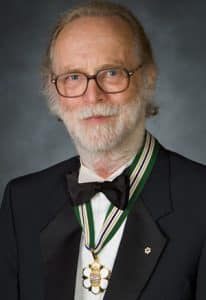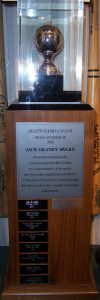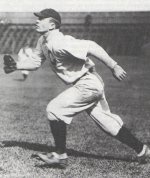Novel “Shoeless Joe” became iconic movie “Field of Dreams”

 St. Marys – A bit of nature and a bit of nurture spurred a passion for baseball in Edmonton’s William Patrick (Bill) Kinsella that, combined with his gift for writing, led to the book “Shoeless Joe,” one of a dozen baseball-themed books written by the proud Canadian. It was that work of art that was adapted into the world-renowned film classic entitled “Field of Dreams,” and has earned Kinsella the 2011 Jack Graney Award, presented by the Canadian Baseball Hall of Fame for a significant contribution to the game of baseball in Canada through a life’s work or for a singular outstanding achievement.
St. Marys – A bit of nature and a bit of nurture spurred a passion for baseball in Edmonton’s William Patrick (Bill) Kinsella that, combined with his gift for writing, led to the book “Shoeless Joe,” one of a dozen baseball-themed books written by the proud Canadian. It was that work of art that was adapted into the world-renowned film classic entitled “Field of Dreams,” and has earned Kinsella the 2011 Jack Graney Award, presented by the Canadian Baseball Hall of Fame for a significant contribution to the game of baseball in Canada through a life’s work or for a singular outstanding achievement.
“I wrote it 30 years ago, and the fact that people are still discovering it makes me proud. It looks like it will stand the test of time,” said a humbled Kinsella, 76, from his home in Yale, British Columbia.
Kinsella, who will be honoured in a ceremony at a time and place to be determined in 2012, was born on May 25, 1935 in Edmonton, and was home-schooled by his mother Olive while being raised near Darwell, a small town 60 miles west of Edmonton. His father John, a plastering contractor, had played minor league baseball in Florida, California, and in the Edmonton area. Bill fell in love with the game playing with friends on sandlots and various school yards beginning when his family moved to Edmonton when he was ten years old, but readily admits there was no place on the field it was safe for him to be.
“If I was playing right field when a left-hander hitter stepped up to the plate, I traded spots with the left fielder!”, added Kinsella, who received the Order of Canada in 1993.
“Shoeless Joe” is the story of a financially struggling, baseball-obsessed Iowa farmer named Ray Kinsella (played by Kevin Costner in the movie) who hears a whispering voice telling him to “Build it and they will come.” He trustingly follows instructions and constructs a stunning baseball field with lights in the middle of his corn crop. He then makes a cross-country trip in order to provide redemption to author J.D. Salinger (changed to Terrance Mann in the film, played by James Earl Jones), and give a second chance of playing against the very best to Dr. Archibald “Moonlight” Graham (Burt Lancaster). The protagonist wins out in the end, as he enables his hero, Shoeless Joe Jackson (Ray Liotta) along with other baseball spirits to play baseball again, recovers his debt from donations by tourists wanting to experience the field of dreams, and gets reunited with his own father in an unforgettable meeting on the magical diamond.
The original publication in 1982 by Houghton Mifflin produced 25,000 hardcover copies and there have been countless paperback versions world wide. 2010 Graney winner Bob Elliott, who was recently named the recipient of Cooperstown’s J.G. Taylor Spink Award, described Shoeless Joe not as a baseball movie, but rather “a movie about fathers and sons.”
The 1989 blockbuster film grossed $85 million world-wide and is commonly referred to as the greatest baseball movie of all-time.
“I still remember sitting in a local movie house in White Rock (B.C.) watching the movie when it came out, and hearing the whole place cry when Ray (the main character) asked his father at the end if they could have a game of catch,” recalled Kinsella.
Kinsella, who rarely misses watching his beloved Toronto Blue Jays, still fosters baseball dreams, as he is a key supporter of a movement in the Okanagan Valley called the British Columbia Youth Baseball Legacy Complex (www.bcyouthbaseballlegacy.com). The BCYBLC represents an impressive vision whereby a 92-acre site will be converted into a baseball complex encompassing diversity, education, and healthy lifestyle components while inspiring tradition and respect for the game through a blend of old-school values.
Kinsella who could read and write by the age of five, won a YMCA contest at the age of 14 for a short story called “Diamond Doom.” The accomplished writer has now penned more than two dozen novels.
Despite a significant setback resulting in concussion from having been struck by a car that put his writing on hold, Kinsella recently released a new novel entitled “Butterfly Winter,” about twin brothers, battery mates growing up, the catcher being somewhat mediocre and the pitcher a potential star, but who can only perform at his peak when pitching to his brother. The title stems from Kinsella’s fascination with Canadian Monarch butterflies migration to Mexico for the winter.
What the Wizard character in Butterfly Winter says about baseball sums up Kinsella’s view on his love for the game: “Whatever torment is raking the soul is put aside.”
“That, and the open-endedness of baseball is what does it for me,” Kinsella continued.
“The foul lines go on forever, and the game is not limited by time.”
Kinsella’s favourite team growing up was the St. Louis Cardinals (“It was their jersey that captured me.”), and his favourite ballpark is Dodger Stadium. The first live major league game he saw was Don Drysdale facing off against Juan Marichal at a very chilly Candlestick Park in San Francisco.
“The Hall of Fame pitchers we saw that night were overshadowed by the miserable weather – we couldn’t find enough blankets!”, remembered Kinsella.
At one point, Kinsella had travelled to every Major League baseball park except Baltimore’s Memorial Stadium.
Kinsella can’t stand artificial turf, but is a fan of the designated hitter.
“The DH just makes for a more interesting game, and the fans aren’t burdened with having to watch a poor hitter flail wildly.”
When asked how fans over the years reacted to his citizenship, Kinsella replied that it was Canadians who were the most surprised, and it really didn’t seem to matter to Americans. They just liked a good story.
As far as the state of Major League Baseball today, Kinsella was saddened to experience the era of performance-enhancing drugs, but he is convinced that, despite any ups and downs, the game itself is so great that it will always win out.
While it is obvious what Kinsella’s top baseball book and movie are, he was quite candid in naming his second favourite.
“I enjoyed the character ‘Crash Davis’ that Kevin Costner played in Bull Durham, but as crazy as this might sound, when I was a boy, I saw a movie called ‘Rhubarb’ and it has stuck with me my whole life. A millionaire bequeaths the ownership of his baseball team to his cat named Rhubarb!”
For generations to come, it will undoubtedly be Bill Kinsella’s timeless novel “Shoeless Joe” that continues to inspire baseball fans and rank as the best of them all, even above Rhubarb!
Previous Winners of the Jack Graney Award
1987 – Neil MacCarl – Toronto Star
1988 – Milt Dunnell – Toronto Star
1990 – Austin “Dink” Carroll – Montreal Gazette
1991 – Joe Crysdale & Hal Kelly – CKEY
1996 – Dave Van Horne – TSN & CIQC
2001 – Tom Cheek – Toronto Blue Jays
2002 – Ernie Harwell – Detroit Tigers
2003 – Allan Simpson – Baseball America
2004 – Jacques Doucet – Montreal Expos
2005 – Len Bramson – TBS Sports
2009 – Ian MacDonald – Montreal Gazette
2010 – Bob Elliott – Sun Media & canadianbaseballnetwork.com
2011 – W. P. Kinsella – “Shoeless Joe” novel adapted to film “Field of Dreams”
 Jack Graney’s road to the big leagues began in St. Thomas, Ontario, where he was born and recommended to the Chicago Cubs by fellow Canadian Baseball Hall-of-Famer, Bob Emslie. After a season in the Cubs organization, Graney was sold to the Cleveland, where he would evolve into a steady, dependable outfielder. His big league resume boasts a number of firsts. When Graney walked to the plate in a game against the Red Sox on July 11, 1914, he became the first batter to face Babe Ruth. Almost two years later, on June 26, 1916, he would be the first major leaguer to bat wearing a number on his uniform. A scrappy leadoff hitter, Graney would lead the American League in walks twice (1917 and 1919) and in doubles once (1916). The speedy Canuck also finished in the top 10 in triples in 1913 and 1916, with 12 and 14 three-baggers respectively. He was also a member of the World Series-winning Indians squad in 1920. Following his playing career, Graney became the first ex-player to make the transition to the broadcast booth, performing radio play-by-play for the Indians from 1932 to 1953.
Jack Graney’s road to the big leagues began in St. Thomas, Ontario, where he was born and recommended to the Chicago Cubs by fellow Canadian Baseball Hall-of-Famer, Bob Emslie. After a season in the Cubs organization, Graney was sold to the Cleveland, where he would evolve into a steady, dependable outfielder. His big league resume boasts a number of firsts. When Graney walked to the plate in a game against the Red Sox on July 11, 1914, he became the first batter to face Babe Ruth. Almost two years later, on June 26, 1916, he would be the first major leaguer to bat wearing a number on his uniform. A scrappy leadoff hitter, Graney would lead the American League in walks twice (1917 and 1919) and in doubles once (1916). The speedy Canuck also finished in the top 10 in triples in 1913 and 1916, with 12 and 14 three-baggers respectively. He was also a member of the World Series-winning Indians squad in 1920. Following his playing career, Graney became the first ex-player to make the transition to the broadcast booth, performing radio play-by-play for the Indians from 1932 to 1953.
For more information, please contact:
Canadian Baseball Hall of Fame & Museum
P.O. Box 1838
140 Queen St. E.
St. Marys, ON, Canada, N4X 1C2
(519) 284-1838 (CBHFM office)
(519) 272-7406 (Tom Valcke’s cell)
Email (personal): [email protected]












